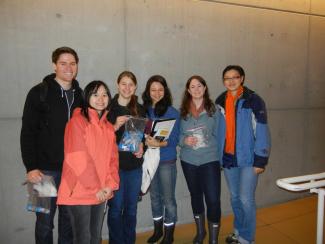PCIGR recently collaborated with a group of 4th-year UBC Environmental Science students on their research project, "Assessment of drinking water at UBC: A consideration of water quality, energy and economic costs, with practical recommendations."
Project objectives
To provide students with a real-world analytical experience where they will determine whether heavy-metal contamination of campus tap water merits cause for concern.

Methods
The water quality assessment investigated the concentration of copper, zinc and lead in water from drinking fountains in 11 buildings on the UBC campus, including a sample of name-brand bottled water available at grocery stores and the WaterFillz station located in the Student Union Building (SUB).
The majority of the sampling was conducted on a Monday morning after 60 seconds of flushing. Additional samples were collected throughout the week (Monday, Wednesday, Friday) and after varying flushing times (0, 30, 60 seconds). Approximately 50 mL of water were collected in clean polypropylene tubes at each location. The water samples were immediately acidifed to 1% HNO3 and subsequently analyzed using PCIGR's Agilent 7700 quadrupole ICP-MS.
Results
The study found elevated concentrations of copper (Cu) and zinc (Zn) in the Earth and Ocean Science (EOS) Main building and Totem Student Residence (~850 ppb Cu), while the Fred Kaiser, Geography, Buchanan A and Scarfe buildings contained moderate concentrations (100–300 ppb Cu).
Initial lead (Pb) results indicated an elevated concentration (~2.5 ppb) in EOS Main in comparison to the other buildings, which contained less than 1 ppb Pb. Further sampling of a second water fountain in EOS Main revealed concentrations of 4.5–10 ppb Pb.
Metal concentrations in the bottled water were found to be the lowest (too low to be detected), followed by WaterFillz filtered water, and the water from fountains in the SUB.
The study also observed a decline in metal concentrations as the week progressed (e.g., 27 to 18 ppb Cu by Friday) and with increasing flushing time (e.g., ~150 to 2 ppb Zn within 60 seconds).
Conclusions
The results indicate that the concentrations of trace heavy metals (copper, zinc and lead) in campus tap water do not exceed the recommended levels stated in Health Canada guidelines (~1 ppm Cu, ~5 ppm Zn, ~10 ppb Pb).
Our analyses show that all the sampled buildings supply adequately safe drinking water, although some samples showed greater concentrations than others (e.g., EOS Main for Pb). Furthermore, this suggests that while fountain water does not pose any significant health risks, flushing for at least 30 seconds and installation of better plumbing and filtration units would improve the current water quality.